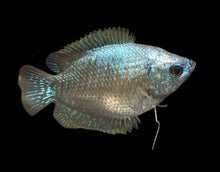Trichogaster lalius
Note: Due
to variations within species, your item may not look identical to the image
provided.
|
Synonyms |
Colisa lalia, Colisa lalius, Polyacanthus lalius, |
|
Distribution |
Bangladesh, |
|
Sexual Dimorphism |
Males are usually more brightly coloured. Females |
|
Maximum |
9cm |
|
Water Parameters |
Acclimatises to a wide range of water conditions. |
|
Temperature |
25-28 |
|
Compatibility |
Community |
|
Lighting |
No |
Care
A beautiful hardy species that is available in a number of
colour strains. Most specimens offered for sale are captive bred, although
delightful, more subtly coloured wild-caught specimens are sometimes available.
Peaceful towards other species of fish, however, males may become territorial
towards other Dwarf Gouramis when kept together in smaller tanks. A
well-planted aquarium with a gentle water flow will help them to feel secure.
Feeding
Offer a varied diet consisting of a good quality flake
food, green flake food, and small frozen foods such as mosquito larvae,
daphnia, and brineshrimp.
Breeding
A conditioned pair should be acclimatised to a long,
shallow aquarium with the temperature set to 29-30 deg C. There should be a
good amount of floating plants, to help when the male constructs his
bubblenest. Once the male has finished building this nest, which can be up to an
inch thick and several inches across, he will begin courting the female. This
is usually in the form of him ?dancing? around the female and flaring his fins.
If the female ?accepts? the male, she will swim underneath the bubblenest,
where the male will embrace her, wrapping his body around hers. He will turn
her onto her side and then her back, at which point, she will release some of
her eggs (up to 60), which the male fertilises immediately. The eggs will float
upwards towards the nest, and any that stray will be collected by the male and
placed into the nest. Once happy that all the eggs are secure, the pair will
repeat their spawning/egg collecting actions several times until up to 600 eggs
in total have been released. The male then secures the eggs by adding another
layer of bubbles beneath the eggs, and it is at this point when the female
should be removed. The male will vigorously defend his nest and surrounding
territory when the tank is approached. After 12-24 hours, the eggs will hatch,
and after another 3 days, they will become free-swimming. The male must be
removed from the tank once the fry leave the bubblenest otherwise he will eat
them. The fry should be fed on tiny foods such as infusoria or finely powdered
fry food for the first week or so, moving on to larger foods as they grow. It
is of extreme importance to maintain a warm layer of air between the surface of
the water and the coverslides at all times whilst the fry are developing their
labyrinth organ, critical during the first few weeks of their life.








